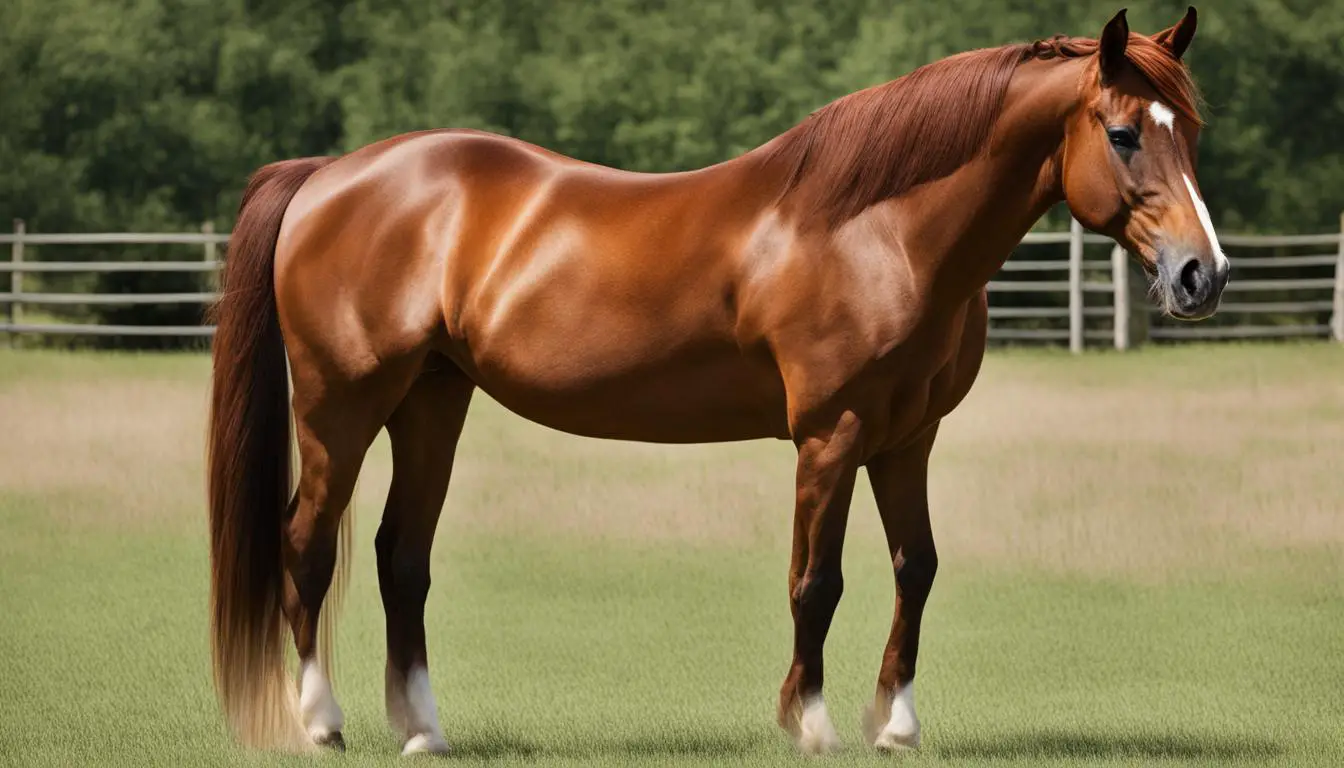Horses are fascinating creatures with unique ways of communicating. One of their most distinctive behaviors is head nodding, which can be observed in various contexts. Understanding the reasons behind this behavior is key to interpreting horse body language and strengthening the bond between horse and human.
Head nodding is a form of equine communication that conveys important messages. Horses may nod their heads for different reasons, each with its own significance. It can indicate excitement, pain or discomfort, the need for attention, irritation, boredom, or even dental issues. By deciphering these head movements, horse owners can gain valuable insights into their horse’s well-being and needs.
So, why do horses nod their heads? Let’s explore the fascinating world of horse head nodding behavior and delve into the intricacies of horse communication, body language, and gestures.
Key Takeaways:
- Horses nod their heads as a form of communication, conveying various messages.
- Head nodding can indicate excitement, pain, the need for attention, irritation, or boredom.
- Observing and interpreting horse head movements is crucial for understanding their needs and well-being.
- Horses may nod their heads to draw attention to themselves or when bothered by insects.
- Nodding can also be a learned behavior or a sign of dental problems or lameness.
Reasons Horses Nod Their Heads
Horses nod their heads for various reasons, and it is an important aspect of their communication cues. Understanding the reasons behind horse head nodding behavior is crucial for horse owners and enthusiasts. Here are some common reasons why horses nod their heads:
- Showing excitement: Horses may nod their heads as a sign of excitement, especially when they see something that piques their interest.
- Indicating pain or discomfort: Head nodding can be a response to pain or discomfort that horses experience, whether it’s due to an injury, illness, or underlying health issue.
- Drawing attention for treats: Horses are intelligent animals and often nod their heads to get their owners’ attention, especially when they associate head nodding with receiving treats or rewards.
- Aiding in chewing: Nodding the head helps horses with chewing their food, allowing them to break down and process their feed more effectively.
- Displaying irritation or annoyance: Horses may nod their heads to express irritation or annoyance, indicating that something is bothering them.
- Releasing endorphins when bored: Nodding can also be a self-soothing behavior that horses exhibit when they are bored or seeking mental stimulation.
- Indicating ear or tooth infections: Head nodding can be a sign of ear or tooth infections, as horses may try to alleviate discomfort by moving their heads.
- Being bothered by insects: Nodding can be a response to insects bothering horses, such as flies buzzing around their faces or other parts of their bodies.
- Exhibiting learned behavioral issues: In some cases, horses may learn to nod their heads as a behavioral issue, which can be addressed through training and behavior modification.
- Signs of lameness or dental problems: Persistent or excessive head nodding can also indicate lameness or dental problems that require veterinary attention and proper treatment.
By understanding these various reasons behind horse head nodding behavior, horse owners can better interpret their horse’s communication cues and provide appropriate care and attention.
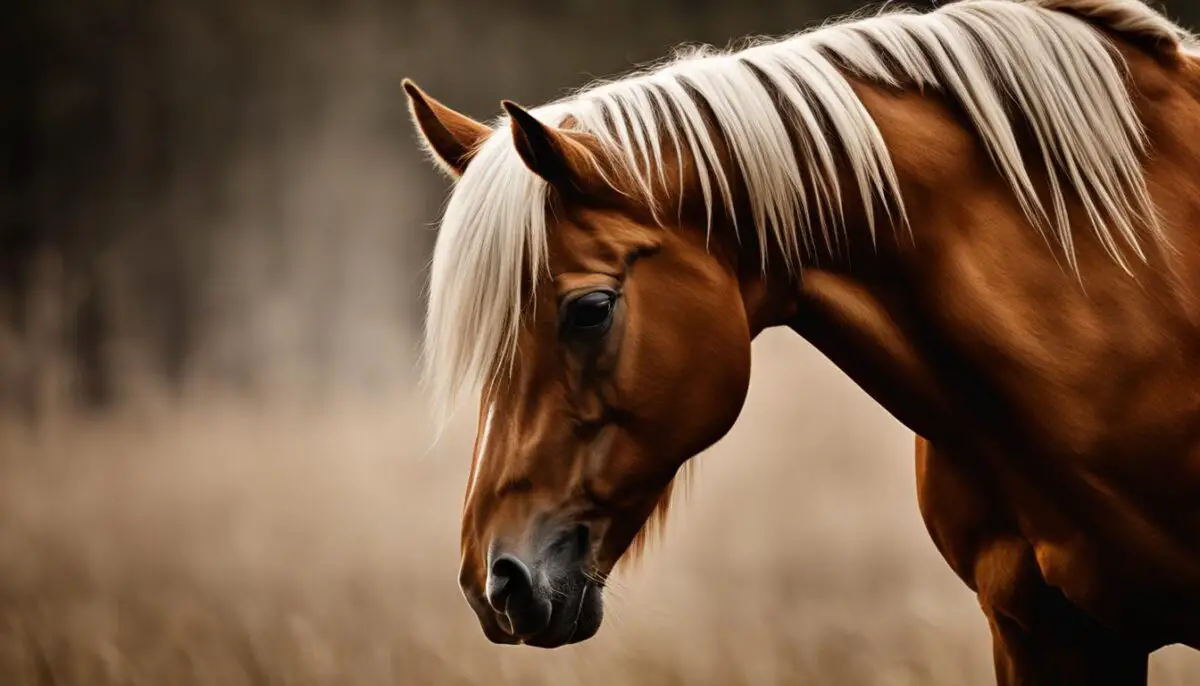
Reasons for Horse Head Nodding
| Reason | Description |
|---|---|
| Showing excitement | Horses nod their heads to express excitement or interest in something. |
| Indicating pain or discomfort | Head nodding can be a response to pain, discomfort, or underlying health issues. |
| Drawing attention for treats | Nodding can be a way for horses to get their owner’s attention and receive treats. |
| Aiding in chewing | Nodding the head helps horses with chewing their food effectively. |
| Displaying irritation or annoyance | Head nodding can indicate that something is bothering or irritating the horse. |
| Releasing endorphins when bored | Horses may nod their heads as a self-soothing behavior when they are bored or seeking mental stimulation. |
| Indicating ear or tooth infections | Head nodding can be a sign of ear or tooth infections, causing discomfort. |
| Being bothered by insects | Nodding can be a response to insects bothering horses, such as flies buzzing around. |
| Exhibiting learned behavioral issues | Horses may learn to nod their heads as a behavioral issue, which can be addressed through training. |
| Signs of lameness or dental problems | Persistent or excessive head nodding can indicate lameness or dental issues that require veterinary attention. |
Horse Nodding and Behavioral Issues
Horse nodding can be associated with behavioral issues. When horses are bored or stressed, they may nod their heads as a way to release endorphins and cope with their environment. Understanding horse behavior and equine behavior is essential for addressing these issues and ensuring the well-being of our equine companions.
To address behavioral issues, it’s important to provide horses with proper care, adequate space, mental and physical stimulation, companionship, regular exercise and training, grooming, and attention. By fulfilling their basic needs and creating a positive environment, we can help reduce instances of horse nodding caused by behavioral issues. Additionally, consulting with a professional can provide valuable insights and guidance in managing and modifying unwanted behaviors.
The Role of Understanding Horse Gestures
Understanding horse gestures and communication cues is crucial when dealing with behavioral issues. By interpreting their body language, we can detect signs of discomfort, anxiety, or boredom, which may trigger head nodding. Recognizing these cues allows us to intervene and alleviate their stress or address the underlying cause of the behavior.
Developing a strong bond with our horses and building trust through consistent and patient training methods is paramount in resolving behavioral issues. Horses thrive on routine and clear communication. When immersed in a positive and structured routine, horses are less likely to engage in repetitive behaviors such as nodding.
Remember, every horse is unique, and their behavioral issues may require tailored solutions. Patience, observation, and a commitment to their well-being are key factors in resolving horse nodding associated with behavioral issues.
| Steps to Address Behavioral Issues: |
|---|
| 1. Implement a consistent routine |
| 2. Provide adequate mental and physical stimulation |
| 3. Ensure proper diet and nutrition |
| 4. Offer companionship and social interaction |
| 5. Engage in regular exercise and training |
| 6. Address any underlying health issues |
| 7. Seek professional guidance, if necessary |
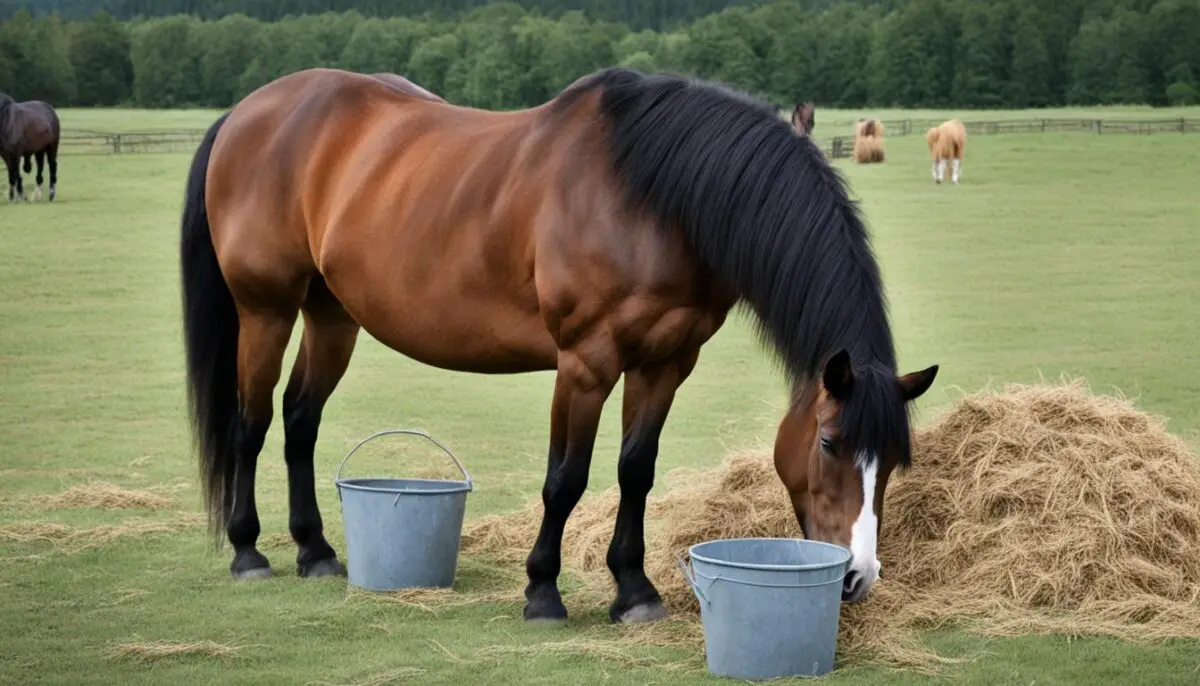
Horse Nodding and Pain or Discomfort
Horses have a unique way of communicating their pain or discomfort through nodding their heads. When horses experience injuries, infections, or lameness, they may resort to nodding as a coping mechanism.
This nodding behavior releases endorphins, providing temporary relief from their discomfort. It’s essential for horse owners and caretakers to understand this aspect of horse body language and gestures.
Common sources of pain or discomfort that can cause horse nodding include:
- Abscesses
- Toothaches
- Swollen tendons
- Hoof infections
Consulting with a veterinarian is crucial for accurately diagnosing the underlying issues and providing appropriate treatment for the horse. Early intervention can prevent further complications and ensure the horse’s well-being.

Common Sources of Horse Pain or Discomfort
| Pain or Discomfort | Description |
|---|---|
| Abscesses | Infection and swelling within the hoof |
| Toothaches | Pain or discomfort in the teeth or gums |
| Swollen tendons | Inflammation of the tendons in the legs |
| Hoof infections | Infections or injuries affecting the hoof |
By recognizing and addressing the pain or discomfort that leads to nodding behavior, horse owners can provide appropriate care and ensure the overall well-being of their equine companions.
Horse Nodding and Environmental Factors
Horse nodding can be influenced by various environmental factors that affect their behavior. Understanding these factors is essential for providing optimal care and ensuring the well-being of horses. Environmental factors such as excitement, excess energy, irritation, and exposure to bright sunlight can all contribute to horse nodding.
When horses are excited, they may show their enthusiasm by nodding their heads. This behavior is a natural response to their heightened energy levels and can be observed during moments of anticipation or arousal.
Horses may also nod when they feel irritated or annoyed. It can be a way for them to express their discomfort or frustration, signaling their need for attention or a change in their environment.
Bright sunlight can also trigger horse nodding. The intensity of the light may cause horses to squint, leading to a repetitive nodding motion as they try to adjust their vision and alleviate any discomfort.
Furthermore, flies and other insects can be a significant annoyance for horses, causing them to nod their heads in an attempt to ward off these pests. The constant buzzing and biting can be quite irritating, prompting the horse to exhibit this behavior as a means of self-defense.
Grooming and Environmental Management
Proper horse care is crucial in mitigating environmental factors that contribute to head nodding. Implementing effective fly control measures, such as fly masks, fly repellents, and well-maintained stables, can help minimize the irritation caused by insects.
Regular grooming is another important aspect of horse care. It not only helps keep the horse’s coat clean and healthy but also allows for early detection of any skin irritations or wounds caused by pests. By addressing these issues promptly, horse owners can prevent excessive head nodding.
Creating a comfortable and stress-free environment for horses is vital. Providing ample shade and shelter can protect them from excessive sunlight exposure. Additionally, ensuring that horses have access to sufficient space for exercise and mental stimulation can help reduce excess energy and minimize behaviors like nodding.
By understanding and addressing the environmental factors that contribute to horse nodding, horse owners can help create a more comfortable and contented living environment for their equine companions.
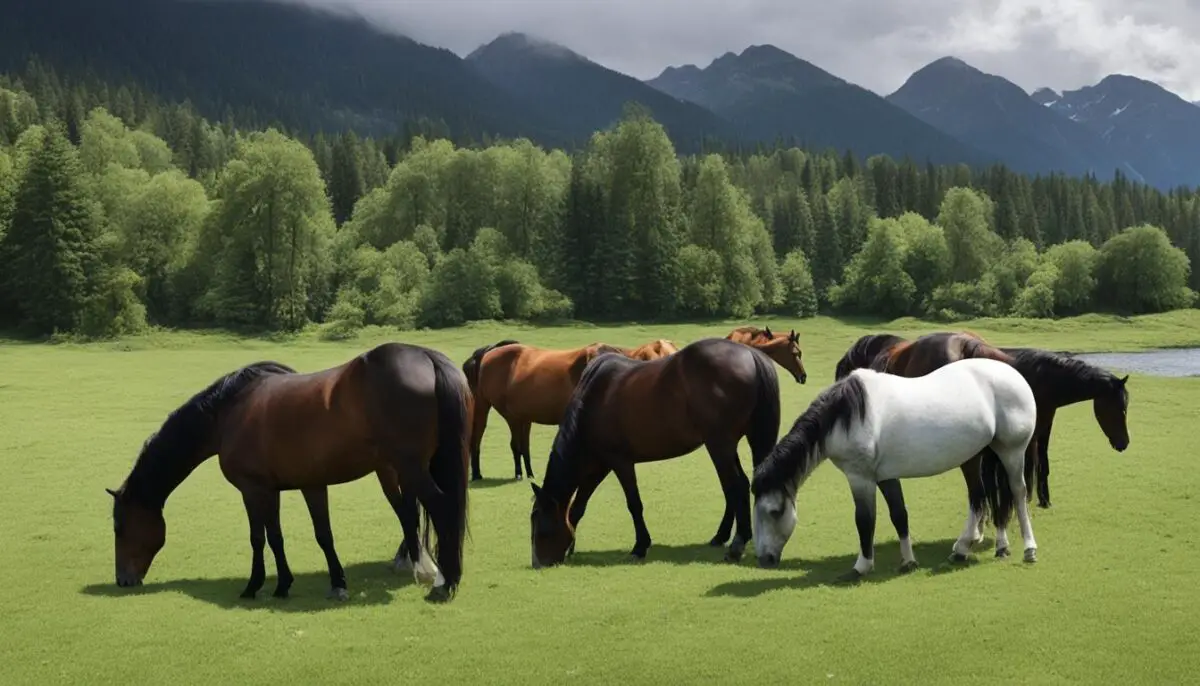
Environmental Factors and Horse Nodding
| Environmental Factors | Effects on Horse Nodding |
|---|---|
| Excitement | Increased head nodding during moments of heightened energy and anticipation |
| Irritation/Annoyance | Horse nodding as a means of expressing discomfort or frustration |
| Bright Sunlight | Nodding in response to intense light, attempting to alleviate squinting and discomfort |
| Insects/Fly Bites | Nodding as a defense mechanism against irritating pests |
Stereotypic Behaviors and Horse Nodding
Horse nodding can be associated with stereotypic behaviors, such as cribbing, weaving, pacing, and head shaking. These behaviors are repetitive and have no apparent function. They are believed to develop in response to stress, frustration, or discomfort. Identifying and addressing the root cause of stereotypic behaviors through improved horse welfare, care, feeding, and management practices is essential to prevent and manage these behaviors.
Stereotypic Behaviors in Horses
Stereotypic behaviors are abnormal repetitive patterns that horses exhibit when they are confined or exposed to a stressful environment. These behaviors can manifest in different forms, including:
- Cribbing: This behavior involves a horse grasping a stationary object, such as a fence or a stall door, with its incisors and sucking in air. It is commonly accompanied by a characteristic grunt sound.
- Weaving: Horses engage in weaving when they repetitively shift their weight from one forelimb to the other while swaying their head and neck from side to side.
- Pacing: Horses show pacing behavior when they move back and forth in a regular pattern along the length of their enclosure.
- Head Shaking: Head shaking is characterized by the horse repeatedly tossing or jerking its head up and down or from side to side without an obvious cause.
Stereotypic behaviors are thought to develop as a coping mechanism to alleviate stress or frustration in horses. They can be triggered by various factors, including confinement, boredom, social isolation, lack of exercise, changes in routine, and inadequate feeding practices.
“Stereotypic behaviors, such as cribbing, weaving, pacing, and head shaking, are abnormal repetitive patterns that horses exhibit when they are confined or exposed to a stressful environment.”
Preventing and Managing Stereotypic Behaviors
Addressing stereotypic behaviors requires a comprehensive approach that focuses on improving horse welfare and reducing stress factors. Here are some strategies to prevent and manage these behaviors:
- Provide ample turnout and opportunities for regular exercise. Allowing horses to graze, interact with other horses, and engage in natural behaviors can help alleviate stress and boredom.
- Offer a balanced diet that meets the horse’s nutritional needs. Proper nutrition plays a crucial role in maintaining overall health and reducing the risk of stereotypic behaviors.
- Enrich the horse’s environment by providing mental and physical stimulation. This can include using toys, puzzles, and feeding methods that encourage natural foraging behaviors.
- Promote social interaction by housing horses in groups whenever possible. Socialization allows horses to establish and maintain social bonds, reducing feelings of isolation and distress.
- Minimize stressors and provide a predictable routine. Horses thrive in an environment that offers consistency, clear boundaries, and a sense of security.
It’s important to note that addressing stereotypic behaviors may require professional guidance. Consulting with a veterinarian, equine behaviorist, or qualified trainer can provide valuable insights and develop a tailored management plan for the individual horse.
Examples of Stereotypic Behaviors in Horses
| Stereotypic Behavior | Description |
|---|---|
| Cribbing | Horse grasps a stationary object and sucks in air, often accompanied by a grunt sound. |
| Weaving | Horse shifts weight from one forelimb to the other while swaying head and neck from side to side. |
| Pacing | Horse moves back and forth in a regular pattern along the length of its enclosure. |
| Head Shaking | Horse repeatedly tosses or jerks its head up and down or from side to side without an obvious cause. |
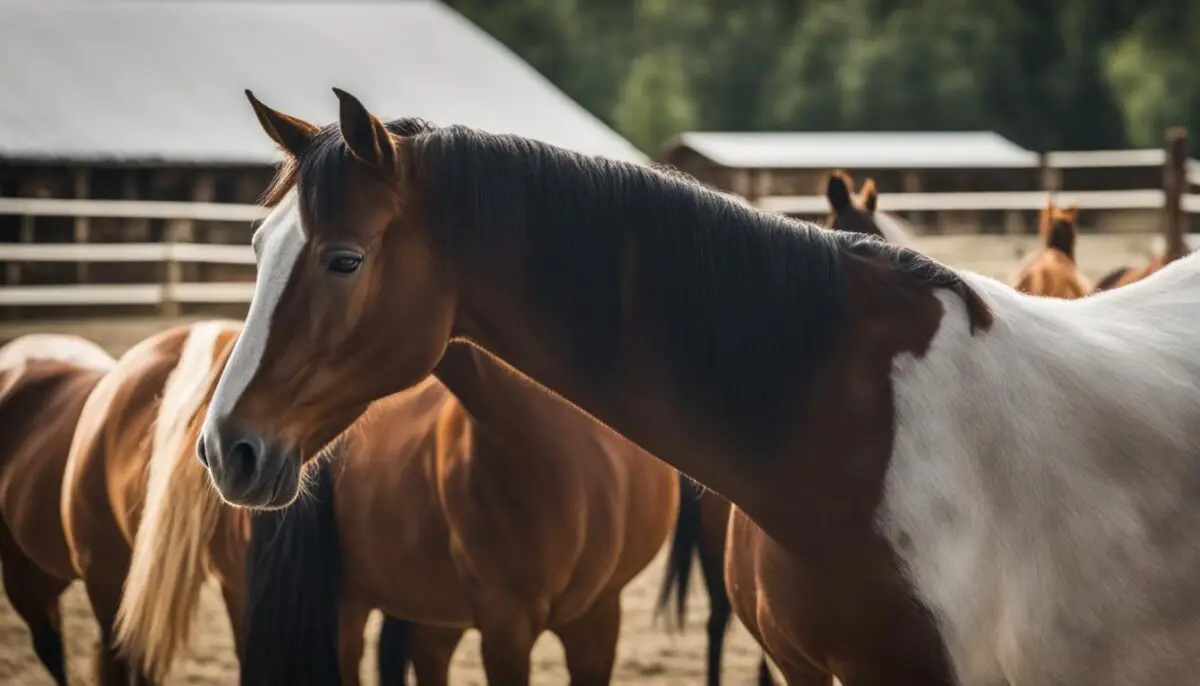
Understanding and addressing stereotypic behaviors in horses is essential for promoting their well-being. By providing a stimulating and stress-free environment, horse owners can help prevent and manage these behaviors, enhancing the overall quality of life for their equine companions.
Horse Nodding While in Motion
Horses exhibit various body language cues, including nodding their heads while in motion. This behavior is a natural part of their vertical head movement and is observed during walking, cantering, and galloping. The interaction between the neck and shoulder muscles contributes to the nodding motion, which can be visually captivating to observe.
While horse nodding while in motion is generally considered normal, excessive nodding, especially during trotting, could indicate an underlying issue such as lameness. It is essential to have a veterinarian evaluate the horse to ensure their well-being and address any potential concerns.
Each gait has specific characteristics and muscle actions that contribute to head movement. Understanding these movements and their significance can provide insights into the horse’s comfort, coordination, and overall equine behavior.
Conclusion
Horse nodding behavior is a fascinating aspect of equine behavior and communication. By understanding horse gestures and body language, horse owners can better interpret their horses’ needs and ensure their well-being.
When a horse nods its head, it can convey various messages. It may indicate excitement, pain or discomfort, the need for attention, irritation or annoyance, boredom, infections, lameness, or dental issues. Being able to recognize and interpret these signals is essential for effective horse care.
Observing and studying a horse’s head movements can provide valuable insights into their physical and emotional state. It allows horse owners to identify any potential health issues or behavioral problems that may require attention. By responding appropriately to their horses’ cues, owners can build a stronger bond and establish clear lines of communication.
Remember, effective understanding of horse nodding behavior requires ongoing learning and observation. Continually educating oneself about equine behavior, horse communication, and horse gestures will enable horse owners to provide the best care possible for their beloved companions.
FAQ
Why do horses nod their heads?
Horses nod their heads for a variety of reasons, including showing excitement, relieving pain or discomfort, drawing attention, aiding in chewing, expressing irritation or annoyance, releasing endorphins when bored, indicating ear or tooth infections, being bothered by insects, and exhibiting learned behavioral issues.
What are the reasons horses nod their heads?
Horses nod their heads to show excitement, indicate pain or discomfort, draw attention for treats, aid in chewing, display irritation or annoyance, release endorphins when bored, indicate ear or tooth infections, be bothered by insects, and exhibit learned behavioral issues. Nodding can also be a sign of lameness or dental problems.
Can horse nodding be associated with behavioral issues?
Yes, horse nodding can be associated with behavioral issues. When horses are bored or stressed, they may nod their heads as a way to release endorphins and cope with their environment. Providing proper care, adequate space, mental and physical stimulation, companionship, regular exercise and training, grooming, and attention can help address behavioral issues.
Why do horses nod their heads when in pain or discomfort?
Horses may nod their heads when in pain or discomfort as a way to alleviate it. This can be seen when they have injuries, infections, or lameness. Nodding releases endorphins and provides temporary relief. Common sources of pain or discomfort include abscesses, toothaches, swollen tendons, and hoof infections. Consulting with a veterinarian is important for proper diagnosis and treatment.
What environmental factors contribute to horse nodding?
Horses may nod their heads when excited, have excess energy, feel irritated, or are exposed to bright sunlight. Flies and other insects can also irritate horses and cause them to nod. Proper horse care, including fly control, regular grooming, and managing the horse’s environment, can help reduce head nodding caused by environmental factors.
What are stereotypic behaviors and how are they related to horse nodding?
Stereotypic behaviors, such as cribbing, weaving, pacing, and head shaking, are repetitive behaviors with no apparent function. They are believed to develop in response to stress, frustration, or discomfort. Identifying and addressing the root cause of stereotypic behaviors through improved horse welfare, care, feeding, and management practices is essential to prevent and manage these behaviors.
Do horses nod their heads while in motion?
Yes, horses do nod their heads while in motion. This vertical head movement is associated with the interaction of the neck and shoulder muscles and is observed during walking, cantering, and galloping. Excessive nodding while trotting can indicate lameness and should be evaluated by a veterinarian.
What is the significance of horse nodding behavior?
Horse nodding behavior has various meanings, including indicating excitement, pain or discomfort, the need for attention, irritation or annoyance, boredom, infections, lameness, or dental issues. Understanding horse body language and gestures is crucial for proper horse care and communication.

